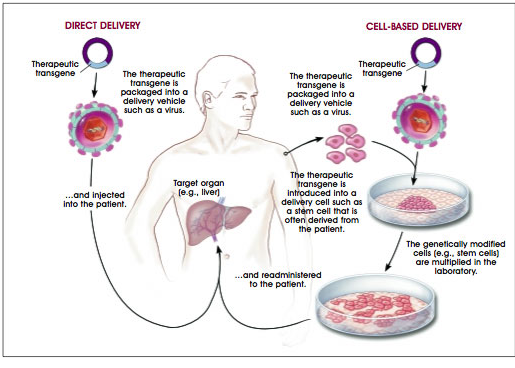The efficient delivery of therapeutic proteins or DNA into specific cells or tissues of an organism to correct a mutant gene is paramount to the success of any gene therapy procedure; and the inserted therapeutic DNA or desired gene must be continuously expressed in vivo at appropriate physiological level in order to correct the mutated gene and thus restore the normal genetic composition of the affected individual.
Gene therapy generally involves the delivery of one or more desired genes and/or proteins into the body so that the inserted gene will spur the synthesis of missing protein or enzymes (whose lack caused the genetic disorder) in the affected individual. But this process of gene delivery is often the most difficult aspect of gene therapy because some of the available methods of delivering desired genes into the body have some deficiencies.
For example, some of the vectors used for gene delivery are viral particles; and these viruses can become pathogenic to the host receiving the gene insert as well as cause several other adverse immunological and inflammatory reactions in the body.
Direct delivery (i.e. in vivo gene therapy) and cell-based delivery (i.e. ex vivo gene therapy) are usually the two main approaches used for delivering therapeutic gene or DNA meant to repair a faulty gene in the body (Figure 1). In direct delivery or in vivo gene therapy, desired genes are delivered into the body by means of viral vectors. But non-viral vectors as shall be seen later in this section are required for the delivery of desired genes or DNA in cell-based delivery or ex vivo gene therapy techniques.

There are two techniques employed in achieving gene therapy:
Gene therapy techniques is usually achieved via in vivo techniques (in which the therapeutic gene or DNA is directly injected into the body) and ex vivo techniques (in which cells are genetically altered in vitro and then injected back into the body).
When cells are extracted or removed from the body of genetic disorder patients and genetically modified in vitro and then transferred back into the same body, the process is known as ex vivo gene therapy. But in the in vivo gene therapy techniques, therapeutic DNA or genes are inserted directly into the body of genetic disorder patients using viral vectors.
References
Alberts B, Bray D, Johnson A, Lewis J, Raff M, Roberts K and Walter P (1998). Essential Cell Biology: An Introduction to the Molecular Biology of the Cell. Third edition. Garland Publishing Inc., New York.
Dale J (2003). Molecular genetics of bacteria. Jeremy W. Dale and Simon Park (4th eds.). John Wiley & Sons Ltd, West Sussex, UK.
Edelstein, M. L., Abedi, M. R., Wixon, J., and Edelstein, R. M. (2004). Gene therapy clinical trials worldwide 1989-2004—an overview. J Gene Med, 6: 597-602.
Ferrua, F.; Brigida, I.; Aiuti, A. (2010). Update on gene therapy for adenosine deaminase-deficient severe combined immunodeficiency. Current Opinion in Allergy and Clinical Immunology. 10 (6): 551–556.
Gardlík R, Pálffy R, Hodosy J, Lukács J, Turna J, Celec P; Pálffy; Hodosy; Lukács; Turna; Celec (2005). Vectors and delivery systems in gene therapy. Med Sci Monit. 11 (4): RA110–21.
Horn PA, Morris JC, Neff T, Kiem HP; Morris; Neff; Kiem (2004). Stem cell gene transfer—efficacy and safety in large animal studies. Mol. Ther. 10 (3): 417–31.
S Li and L Huang (2000). Nonviral gene therapy: promises and challenges. Gene Therapy, 7:31-34. www.nature.com/gt
Salmons B, Günzburg WH; Günzburg (1993). Targeting of retroviral vectors for gene therapy. Hum Gene Ther. 4 (2): 129–41.
Sambrook, J., Russell, D.W. (2001). Molecular Cloning: a Laboratory Manual, 3rd edn. Cold Spring Harbor Laboratory Press, New York.
Sheridan C (2011). Gene therapy finds its niche. Nature Biotechnology. 29 (2): 121–128.
Tamarin Robert H (2002). Principles of Genetics. Seventh edition. Tata McGraw-Hill Publishing Co Ltd, Delhi.
Twyman R.M (1998). Advanced Molecular Biology: A Concise Reference. Bios Scientific Publishers. Oxford, UK.
Vannucci, L; Lai, M; Chiuppesi, F; Ceccherini-Nelli, L; Pistello, M (2013). Viral vectors: A look back and ahead on gene transfer technology. The new microbiologica. 36 (1): 1–22.
Discover more from #1 Microbiology Resource Hub
Subscribe to get the latest posts to your email.


